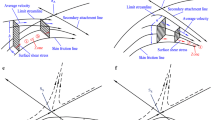Abstract
Topological structure and stability of a slender cross flow is discussed by the stability theory of dynamic system. The inner boundary of flow field was limiting streamline and it was proved that the topological structure connected saddles by limiting streamline is stable. It is proved that the development of slender vortices leads to the change of topological structure about cross flow. And it is the change from stable and symmetrical vortices flow pattern to unstable and symmetrical vortices flow pattern, and then to stable and asymmetrical vortices flow pattern due to little disturbance which leads to the development of asymmetrical slender vortices. The influence of disturbance to flowfield structure was discussed by unfolding theory too.
Similar content being viewed by others
References
Keener E R, Chapman G T. Similarity in vortex asymmetric over slender bodies and wings [J].AIAA J, 1977,12(15):1370–1372.
Ericsson L E. Sources of high alpha vortex asymmetry at zero sideslip[J].Journal of Aircraft, 1992,29(6):1086–1090.
Peake D J, Tobak M. Three dimensional interactions and vortical flow with emphasis on high speeds [R]. AGARD-AG-252, 1980.
Nishioka M, Sato H. Mechanism of determination of the shedding frequency of vortices behind a cylinder at low Reynolds numbers[J].Journal of Fluid Mechanics, 1978,89(1):49–60.
LI Guo-hui, DENG Xue-ying. Topological structure evolution and stability of the cross flow pattern around a slender[J].Journal of BUAA, 2001,27(6):674–676. (in Chinese)
Maskell E C. Flow separation in three dimensions[R]. RAE Aero Rept,2565, 1955.
LU Qi-shao.Qualitative Method of Differential Equation and Bifurcation[M]. Beijing: BUAA Press, 1989. (in Chinese)
Lowson M V, Ponton A J. Symmetry breaking in vortex flows on conical bodies[J].AIAA J, 1992,30(6):1341–1352.
Werlé H. La Tunnel hg drodgnanique au service de la recherche aerospatiale[R]. ONERA Publication, No 156,1974.
CHEN Xue-rui, DENG Xue-ying, WANG Yan-kui,et al. Influence of nose perturbations on behaviors of asymmetric vortices over slender body[J].Acta Mechanica Sinica, 2002,18(6):581–593.
Luo S C, Lim T T, Lua K B,et al. Flowfield around ogive/elliptic-tip cylinder at high angle of attack[J].AIAA J, 1988,36(10):1778–1787.
Bernhardt J E, Williams D R. Proportional control of asymmetric forebody vortices[J].AIAA J, 1988,36(11):2087–2093.
Bridges D H, Homung H G. Elliptic tip effects on the vortex wake of an axisymmetric body at incidence[J].AIAA J, 1994,32(7):1437–1445.
Wardlow A B Jr, Yanta W J. Asymmetric flowfield development on a slender body at high incidence[J].AIAA J, 1984,22(2):233–245.
Author information
Authors and Affiliations
Additional information
Contributed by Deng Xue-ying
Foundation items: the National Natural Science Foundation of China (10172017); the Aviation Science Foundation of China (02A51048)
Biography: Li Guo-hui (1966∼)
Rights and permissions
About this article
Cite this article
Guo-hui, L., Xue-ying, D. Stability of the crossflow pattern around a slender and influence of disturbance. Appl Math Mech 25, 1354–1364 (2004). https://doi.org/10.1007/BF02438292
Received:
Revised:
Issue Date:
DOI: https://doi.org/10.1007/BF02438292



